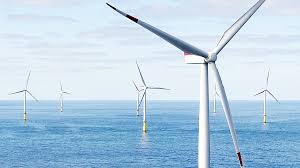U.S. Interior Announces First Offshore Wind Lease Sale in the Pacific

The U.S. Department of Interior on Oct. 18 announced that the Bureau of Ocean Energy Management will hold an offshore wind energy lease sale on Dec. 6, 2022, for regions on the Outer Continental Shelf off central and northern California. The sale is expected to play a key role in helping the Biden administration reach its deployment goals of 30 gigawatts by 2030 and 15 gigawatts of floating offshore wind energy by 2035.
The offshore wind energy lease sale will be the first of its kind on the U.S.’s west coast and the first-ever U.S. sale to encourage possible commercial-scale floating offshore wind energy expansion. The lease sale is considered a step forward in unravelling the significant offshore wind energy potential across the U.S. and will assist in combating the negative effects of climate change. Moreover, the increased use of renewable energy will help lower energy costs for U.S. families and assist local economies by providing high paying union jobs.
The lease sale held by the bureau builds upon the leasing pathway announced last year by U.S. Interior Secretary Deb Haaland. In May 2021, Secretary Haaland and California Governor Gavin Newson together with the Biden administration declared an accord to increase areas for wind energy expansion offshore the northern and central coasts of the state of California.
As part of the sale, the bureau will present five California Outer Continental Shelf lease areas that add up to around 373,268 acres with the capacity to generate over 4.5 GW of offshore wind energy and provide electricity to more than 1.5 million homes.
Leading up to the lease auction, the California final sale notice will be issued in the Federal Register in the coming days, which gives comprehensive information about the final lease areas, lease terms and requirements, and auction details. It also classifies eligible businesses who can take part in the lease auction.
In August, California adopted a report establishing an offshore wind planning goal of 25 gigawatts by 2045. The report sets an interim planning goal range of 2 to 5 gigawatts by 2030, which could result in sufficient electricity to power 3.75 million initially and 25 million homes by mid-century. Subsequently, last month, the Biden administration announced that it will aim to deploy 15 gigawatts of floating offshore wind capacity by 2035 and create a “Floating Offshore Wind Shot” to reduce floating technology costs by over 70 percent by 2035 to $45 per megawatt hour. The initiative targets deep-water lease areas to reach the 15-gigawatt goal.
EnerKnol Pulses like this one are powered by the EnerKnol Platform—the first comprehensive database for real-time energy policy tracking. Sign up for a free trial below for access to key regulatory data and deep industry insights across the energy spectrum.
ACCESS FREE TRIAL